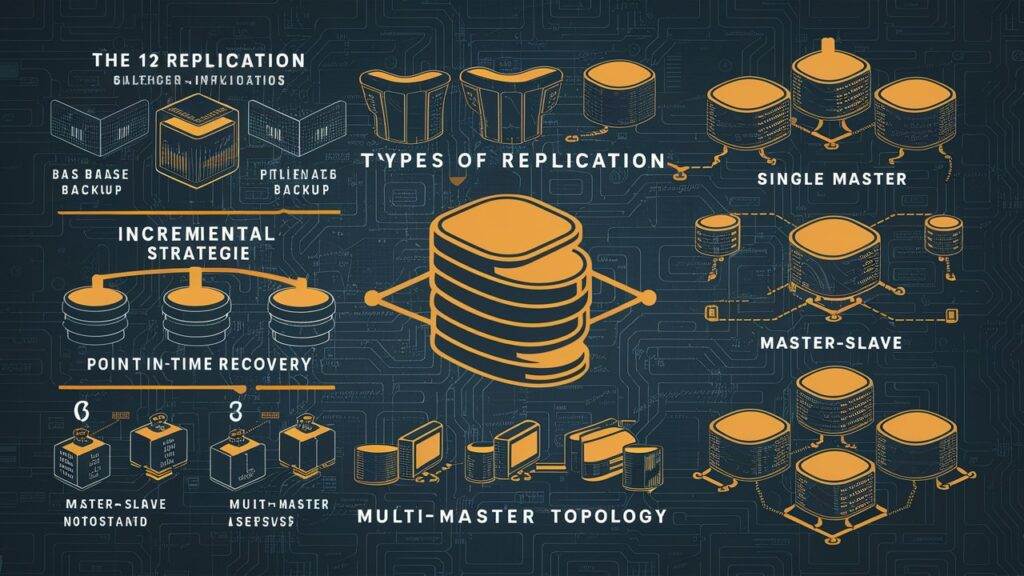PostgreSQL offers multiple replication methods, including streaming replication, to cater to diverse needs. Understanding these Postgres replication types helps in selecting the best strategy for database replication.
PostgreSQL Replication Overview
Importance of Replication in PostgreSQL
Replication is super important in PostgreSQL database management. It boosts performance and reliability, making sure your data is always accessible, even if there are server issues or maintenance work going on. This is key for businesses that need constant access to their databases.
Besides keeping things running smoothly, replication helps with disaster recovery. If something unexpected happens—like a hardware failure or a natural disaster—having replicated data means you can quickly restore everything. This cuts down on downtime and potential data loss. Plus, load balancing is another big win; it spreads out read queries across multiple replicas, which speeds up response times and eases the load on the primary server. This not only makes users happy but also makes better use of resources.
What is PostgreSQL Replication?
PostgreSQL replication is all about copying and keeping database objects consistent across different databases. The goal? To ensure redundancy and consistency. At the heart of this process lies the Write-Ahead Logging (WAL) mechanism, which tracks changes made to the primary database.
When updates occur in the primary database, they get logged in WAL files. Standby servers or replicas use these logs to apply changes instantly. This setup keeps all replicas aligned with the primary database, providing a solid way to maintain data integrity and availability.
Types of Replication in PostgreSQL: An Introduction
PostgreSQL has several replication methods that cater to different needs:
- Streaming Replication: This method sends updates from the primary server to standby servers continuously using WAL files. It offers near real-time synchronization and is favored for its simplicity.
- Logical Replication: Unlike physical replication that copies entire databases at a binary level, logical replication lets you pick specific tables or datasets for synchronization. This flexibility allows users to replicate just what they need.
- Physical Replication: This approach replicates an entire database cluster at a binary level using WAL files. It’s great for scenarios where complete redundancy is necessary but can be heavier on resources than other methods.
- Single Master Replication: In this straightforward setup, one master server manages all write operations while replicas handle read requests. It’s easy to manage but may limit how much writing can be done at once.
- Multi-Master Replication: A more complex option that allows multiple nodes to accept writes simultaneously requires careful conflict resolution strategies because two nodes could try writing to the same record at once.
When picking a replication method in PostgreSQL, think about factors like data consistency needs, latency issues, and your system’s overall architecture. Each method has its own pros and cons based on what you’re trying to achieve.
Understanding these aspects of PostgreSQL replication—its importance, various methods available, and potential challenges—can help you make informed decisions about how best to implement it within your organization’s infrastructure.
Streaming Replication
Streaming replication in PostgreSQL is a feature that allows real-time data transfer from a primary server to one or more standby servers. This ensures that standby servers have an up-to-date copy of the primary database, which is essential for achieving database high availability and effective disaster recovery.
The heart of streaming replication lies in the Write-Ahead Logging (WAL) mechanism. This system continuously sends changes made on the primary server to the standby servers, minimizing lag between them. It also supports read-only queries on standby servers, helping to balance load and boost overall performance.
Streaming Replication Mechanism
The streaming replication mechanism works through WAL shipping, where changes are logged before being applied to the database. Here’s how it functions:
Primary Server Role: To enable streaming replication, the primary server needs proper configuration. Key settings in postgresql.conf include:
- Turning on WAL archiving.
- Setting parameters like
wal_leveltoreplica.
Also, adjustments in the pg_hba.conf file are necessary to allow connections from standby servers.
Standby Server Role: On the standby side, you need to set up recovery settings in recovery.conf. Important parameters include:
- Each type of replication discussed has its own advantages.
- Readers are encouraged to explore advanced configurations tailored to their specific requirements.
Grasping these roles is crucial for establishing a successful streaming replication setup that maintains data integrity and availability.
Setting Up Streaming Replication
To configure streaming replication effectively in PostgreSQL, follow these steps:
By following these guidelines closely, you can set up an efficient streaming replication tailored specifically to your PostgreSQL environment’s requirements.

Logical Replication
Logical replication is a method that allows selective data replication between databases. Unlike physical replication, which copies the entire database at the block level, logical replication targets specific tables or datasets. This targeted approach offers more flexibility and is particularly useful when only certain data needs to be shared across different systems.
One of the key advantages of logical replication is its ability to support heterogeneous environments. For instance, it enables you to replicate data from one PostgreSQL database to another system or even a different version of PostgreSQL. This feature is invaluable for organizations looking to integrate older systems with modern applications or during data migration in upgrades.
Setting Up Logical Replication
To set up logical replication in PostgreSQL effectively, you need to configure both the publisher and subscriber nodes. The publisher sends changes made to its tables (known as publications), while the subscriber receives those changes (subscriptions).
Common scenarios where logical replication proves beneficial include multi-tenant applications needing isolated tenant data while still allowing shared resources and reporting setups requiring aggregated views from multiple databases.
Advanced Setups in Logical Replication
For organizations with more complex architectures involving multiple databases or regions, advanced setups such as multi-standby and cascade configurations can be employed:
These advanced configurations require careful planning regarding network bandwidth and latency but can significantly improve your overall database architecture’s performance and reliability.
Understanding logical replication within PostgreSQL opens up numerous opportunities for efficient data management and integration across diverse environments. By leveraging publications and subscriptions effectively while considering advanced configurations like multi-standby and cascading setups, organizations can develop robust solutions tailored to their unique needs in today’s dynamic landscape of data management strategies.
Physical Replication
Physical replication in PostgreSQL is a key process that involves copying the physical files of a database cluster from a primary server to a standby server. This ensures that the standby server has an exact replica of the primary server’s data, which is vital for high availability and disaster recovery. The Write-Ahead Logging (WAL) mechanism plays an essential role here. It logs all changes made to the database before they are applied, ensuring data integrity and consistency across both servers. This setup allows for smooth failover and minimizes downtime.
How WAL is Used in Physical Replication
The Write-Ahead Log (WAL) is fundamental to physical replication. It records every change made to the database before those changes are written to disk. In a typical physical replication setup, WAL files are shipped from the primary server to the standby server. The standby then applies these logs in sequence, keeping it synchronized with the primary database. This capability for real-time updates means both servers reflect identical data states at any moment, boosting overall system reliability.
Setting Up Physical Replication
To configure physical replication effectively in PostgreSQL, follow these steps:
Best practices include ensuring reliable network connections between servers, regularly monitoring WAL file sizes, and implementing effective failover mechanisms. These steps help maintain strong performance and stability in your replication setup.
Synchronous vs. Asynchronous Physical Replication
In physical replication setups, you can choose between synchronous and asynchronous modes:
Choosing between these methods depends on your application’s tolerance for latency versus its need for consistent data during failures.
Best Practices for Efficient Physical Replication Setup
To ensure an efficient physical replication setup in PostgreSQL:
By following these guidelines and understanding how each component works within PostgreSQL’s framework of physical replication, you can build strong high availability solutions suited to your operational needs.

Single Master and Multi-Master Replication
Single Master Replication
Single master replication is a well-known database setup where one primary server takes care of all write operations. Meanwhile, one or more standby servers replicate this data for read purposes or in case of failover. This method keeps data consistent because all changes come from a single source. It also makes management easier and reduces the chances of conflicts.
The benefits of single master replication include:
However, this system does have drawbacks. It can create bottlenecks at the primary server, especially when there are many write requests. Scalability can also become an issue as demand increases.
Multi-Master Replication
On the flip side, multi-master replication allows multiple servers to accept write operations at the same time. This design boosts availability and scalability by spreading out the load among several nodes. It’s particularly useful in locations where quick local write access is important for performance.
While multi-master replication has its perks, such as better availability and load distribution, it also brings challenges:
There are two main types of multi-master replication: asynchronous and synchronous. Asynchronous multi-master replication allows for some delay between updates across servers, while synchronous ensures that all updates happen simultaneously on all nodes.
Comparisons and Best Practices
When choosing between single master and multi-master replication models, organizations should think about factors like application architecture, expected load patterns, and how users are spread out geographically.
By following these guidelines and recognizing the strengths and weaknesses of each approach—single master versus multi-master—organizations can implement a PostgreSQL replication strategy that meets their needs while ensuring high availability and reliability of their databases.

